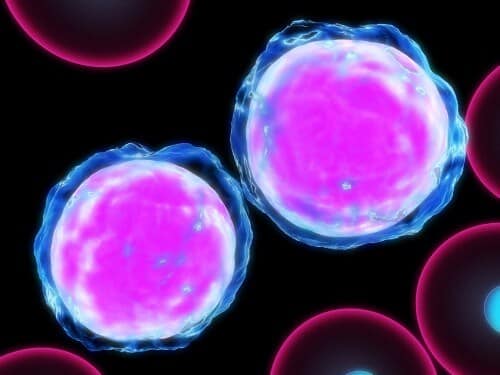The survival of leukemic cells depends precisely on the normal, non-mutant copy of the gene that causes acute myeloid leukemia

Leukemia cells succeed in doing what many people dream of doing. They manage to live almost forever. How do they do it? Weizmann Institute of Science scientists discovered that in about a quarter of leukemia cases, an internal "horror balance" responsible for their survival and reproduction is activated in the cancer cells. When a version of a particular gene is mutated, the mutated gene becomes a cancer-promoting oncogene. However, it turns out that it is the original, normal, version of the gene, alongside the mutation version, that keeps the cancer cell alive, maintains its cancerous nature and allows it to cause devastating damage to the body. These findings were published recently in the scientific journal Cell reports.
The gene in question, RUNX1, plays an essential role in the development and maintenance of the circulatory system. The gene codes for a protein that functions as a transcription factor: a protein that controls the expression of many other genes. In the blood system, RUNX1 directs the differentiation of stem cells found in the bone marrow, so that they develop into different types of mature blood cells. A single mutation in the RUNX1 gene in these stem cells is enough to send them down the slippery slope leading to cancerous transformation. An example of this is acute myeloid leukemia (AML), which is caused by a certain type of mutation caused by the migration of part of chromosome 8 into the RUNX1 gene, on chromosome 21. As a result, a cancer gene (oncogene) is formed that expresses a fusion protein, which includes both components of RUNX1 and which originate from the additional genetic piece. The condensed protein is the cause of leukemia. The most common leukemia among children, ALL, develops in a similar process.
"The fused cancer protein, which directly regulates the activity of many genes, causes a series of additional genetic changes in the cell," says Prof. Yoram Groner from the Department of Molecular Genetics, who headed the research team, and who previously carried out a number of studies that focused on the RUNX1 gene and other genes found on chromosome 21. In these studies, Prof. Groner, among other things, succeeded in deciphering the role of RUNX1 in the leukemia that attacks Down syndrome patients.
The current research was led by the post-doctoral researcher Dr. Oren Ben Ami, from Prof. Gruner's group, and the members of the research group of Dr. Amos Tani from the Department of Computer Science and Applied Mathematics participated in it. In preparation for the current study, the scientists scanned a variety of databases, and noticed an unusual phenomenon: the clinical data suggested that the normal copy of the RUNX1 gene - the one that has not been mutated - is always preserved in the leukemic cells, and its activity is high. It is known that in each of the cells of our body there are two copies of each gene: one that originates from the mother and another that originates from the father. The mutations that cause cancer occur in only one of these two copies, and cause the development of the disease. The healthy copy, on the other hand, is usually silenced, so that only the mutant copy is expressed.
In this case it appears that the healthy copy of RUNX1 is not silenced in the leukemic cells. This fact raised the suspicion that the healthy copy also plays a role in the development of the disease. But how does he do it, and at what stage? To answer the question, the scientists grew leukemic cells, in some of which the mutant copy of the RUNX1 gene was silenced, in some the normal copy was silenced, and in some both copies functioned normally. It turned out that when the normal copy is silenced, the cells die. In contrast, the cells in which both copies were active retained their cancerous nature. A careful examination showed that these cancer cells managed to escape from a pathway of cell death called apoptosis - a suicide mechanism designed, among other things, to prevent the survival and reproduction of cells carrying cancer mutations. In other words, it seems that the normal copy of RUNX1, and not the mutant copy, is responsible for the tenacious survival of cancer cells - one of their most dangerous properties.
Prof. Gruner says that the leukemic cells are "addicted" to the normal version of RUNX1, that is, they are physiologically dependent on it for their survival. "Over time, the spliced oncogenic gene acquires 'expertise' in turning the cells into cancer cells. As the intracellular cancer process progresses, the cell needs the 'horror balance' between the two versions of the gene in order to exist."
The new insight revolutionizes the understanding of leukemia. The scientists believe that the surprising discovery will lead to the development of advanced, efficient and accurate methods for diagnosing these types of leukemia and treating the disease.
Leukemic stem cells, which contain side by side both the mutant copy of the RUNX1 gene and its normal copy, have acquired characteristics of acute myeloid leukemia (AML) cancer cells. The silencing of the normal, non-mutant copy of the gene causes the cells to die and the cancer process to stop
